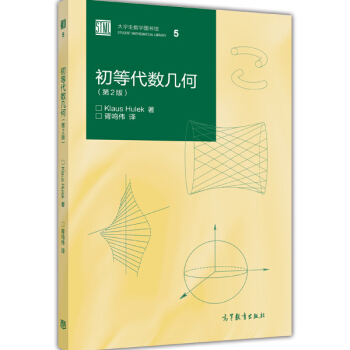![高等线性代数(第3版) [Advanced Linear Algebra]](https://pic.windowsfront.com/10096491/d45d9843-3e72-48eb-88af-3dfd8df0b4d0.jpg)

具体描述
内容简介
is a thorough introduction to linear algebra,for the graduate or advanced undergraduate student。 Prerequisites are limited to a knowledge of the basic properties of matrices and determinants。 However,since we cover the basics of vector spaces and linear transformations rather rapidly,a prior course in linear algebra (even at the sophomore level),along with a certain measure of "mathematical maturity," is highly desirable。内页插图
目录
Preface to the Third Edition,viiPreface to the Second Edition,ix
Preface to the First Edition,xi
Preliminaries
Part 1: Preliminaries
Part 2: Algebraic Structures
Part I-Basic Linear Algebra
1 Vector Spaces
Vector Spaces
Subspaces
Direct Sums
Spanning Sets and Linear Independence
The Dimension of a Vector Space
Ordered Bases and Coordinate Matrices
The Row and Column Spaces of a Matrix
The C0mplexification of a Real Vector Space
Exercises
2 Linear Transformations
Linear Transformations
The Kernel and Image of a Linear Transformation
Isomorphisms
The Rank Plus Nullity Theorem
Linear Transformations from Fn to Fm
Change of Basis Matrices
The Matrix of a Linear Transformation
Change of Bases for Linear Transformations
Equivalence of Matrices
Similarity of Matrices
Similarity of Operators
Invariant Subspaces and Reducing Pairs
Projection Operators
Topological Vector Spaces
Linear Operators on Vc
Exercises
3 The Isomorphism Theorems
Quotient Spaces
The Universal Property of Quotients and the First Isomorphism Theorem
Quotient Spaces,Complements and Codimension
Additional Isomorphism Theorems
Linear Functionals
Dual Bases
Reflexivity
Annihilators
Operator Adjoints
Exercises
4 Modules I: Basic Properties
Motivation
Modules
Submodules
Spanning Sets
Linear Independence
Torsion Elements
Annihilators
Free Modules
Homomorphisms
Quotient Modules
The Correspondence and Isomorphism Theorems
Direct Sums and Direct Summands
Modules Are Not as Nice as Vector Spaces
Exercises
5 Modules II: Free and Noetherian Modules
The Rank of a Free Module
Free Modules and Epimorphisms
Noetherian Modules
The Hilbert Basis Theorem
Exercises
6 Modules over a Principal Ideal Domain
Annihilators and Orders
Cyclic Modules
Free Modules over a Principal Ideal Domain
Torsion-Free and Free Modules
The Primary Cyclic Decomposition Theorem
The Invariant Factor Decomposition
Characterizing Cyclic Modules
lndecomposable Modules
Exercises
Indecomposable Modules
Exercises 159
7 The Structure of a Linear Operator
The Module Associated with a Linear Operator
The Primary Cyclic Decomposition of VT
The Characteristic Polynomial
Cyclic and Indecomposable Modules
The Big Picture
The Rational Canonical Form
Exercises
8 Eigenvalues and Eigenvectors
Eigenvalues and Eigenvectors
Geometric and Algebraic Multiplicities
The Jordan Canonical Form
Triangularizability and Schurs Theorem
Diagonalizable Operators
Exercises
9 Real and Complex Inner Product Spaces
Norm and Distance
Isometrics
Orthogonality
Orthogonal and Orthonormal Sets
The Projection Theorem and Best Approximations
The Riesz Representation Theorem
Exercises
10 Structure Theory for Normal Operators
The Adjoint of a Linear Operator
Orthogonal Projections
Unitary Diagonalizability
Normal Operators
Special Types of Normal Operators
Seif-Adjoint Operators
Unitary Operators and Isometries
The Structure of Normal Operators
Functional Calculus
Positive Operators
The Polar Decomposition of an Operator
Exercises
Part Ⅱ-Topics
11 Metric Vector Spaces: The Theory of Bilinear Forms
Symmetric Skew-Symmetric and Alternate Forms
The Matrix ofa Bilinear Form
Quadratic Forms
Orthogonality
Linear Functionals
Orthogonal Complements and Orthogonal Direct Sums
Isometrics
Hyperbolic Spaces
Nonsingular Completions ofa Subspace
The Witt Theorems: A Preview
The Classification Problem for Metric Vector Spaces
Symplectic Geometry
The Structure of Orthogonal Geometries: Orthogonal Bases
The Classification of Orthogonal Geometries:Canonical Forms
The Orthogonal Group
The Witt Theorems for Orthogonal Geometries
Maximal Hyperbolic Subspaces of an Orthogonal Geometry
Exercises
12 Metric Spaces
The Definition
Open and Closed Sets
Convergence in a Metric Space
The Closure of a Set
Dense Subsets
Continuity
Completeness
Isometrics
The Completion of a Metric Space
Exercises
13 Hilbert Spaces
A Brief Review
Hilbert Spaces
Infinite Series
An Approximation Problem
Hilbert Bases
Fourier Expansions
A Characterization of Hilbert Bases
Hilbert Dimension
A Characterization of Hilbert Spaces
The Riesz Representation Theorem
Exercises
14 Tensor Products
Universality
Bilinear Maps
Tensor Products
When Is a Tensor Product Zero?
Coordinate Matrices and Rank
Characterizing Vectors in a Tensor Product
Defining Linear Transformations on a Tensor Product
The Tensor Product of Linear Transformations
Change of Base Field
Multilinear Maps and Iterated Tensor Products
Tensor Spaces
Special Multilinear Maps
Graded Algebras
The Symmetric and Antisymmetric Tensor Algebras
The Determinant
Exercises
15 Positive Solutions to Linear Systems:Convexity and Separation
Convex Closed and Compact Sets
Convex Hulls
Linear and Affine Hyperplanes
Separation
Exercises
16 Affine Geometry
Affine Geometry
Affine Combinations
Affine Hulls
The Lattice of Flats
Affine Independence
Affine Transformations
Projective Geometry
Exercises
17 Singular Values and the Moore-Penrose Inverse
Singular Values
The Moore-Penrose Generalized Inverse
Least Squares Approximation
Exercises
18 An Introduction to Algebras
Motivation
Associative Algebras
Division Algebras
Exercises
19 The Umbral Calculus
Formal Power Series
The Umbral Algebra
Formal Power Series as Linear Operators
Sheffer Sequences
Examples of Sheffer Sequences
Umbral Operators and Umbral Shifts
Continuous Operators on the Umbral Algebra
Operator Adjoints
Umbral Operators and Automorphisms of the Umbral Algebra
Umbral Shifts and Derivations of the Umbral Algebra
The Transfer Formulas
A Final Remark
Exercises
References
Index of Symbols
Index
前言/序言
Let me begin by thanking the readers of the second edition for their many helpful comments and suggestions, with special thanks to Joe Kidd and Nam Trang. For the third edition, I have corrected all known errors, polished and refined some arguments (such as the discussion of reflexivity, the rational canonical form, best approximations and the definitions of tensor products) and upgraded some proofs that were originally done only for finite-dimensional/rank cases. I have also moved some of the material on projection operators to an earlier oosition in the text.用户评价
我是一名在职的工程师,在工作中经常会遇到需要用到线性代数知识解决工程问题的情况。之前我一直依赖于一些工程数学的教材,但总觉得在理论深度上有所欠缺,很多时候只能停留在应用的层面,无法真正理解其本质。这本书的出现,无疑为我打开了新的大门。它以一种非常系统的方式,梳理了高等线性代数的精髓,让我得以从更根本的层面去理解那些我以往只是“会用”的工具。我特别喜欢书中对一些抽象概念的形象化解释,这对于我这样的工程背景的读者来说,非常有帮助。它让我在解决实际问题的过程中,能够更加得心应手,也更能洞察问题的本质。这本书让我重新找回了学习数学的乐趣,也让我看到了数学在工程领域更广阔的应用前景。
评分说实话,一开始我拿到这本书的时候,并没有抱太大的期望。我是一名跨专业的学生,接触高等线性代数纯粹是为了完成学业要求,觉得可能就是枯燥乏味的定理和证明堆砌。然而,当我真正开始翻阅它的时候,我被深深地吸引了。这本书的编排非常有条理,从最基础的概念讲起,循序渐进,一点一点地揭示出那些看似复杂的数学体系是如何构建起来的。那种豁然开朗的感觉,真的是无与伦比。而且,书中穿插的一些历史背景和应用案例,更是让原本抽象的理论变得生动有趣起来。我甚至发现,原来线性代数在很多我们日常生活中接触到的领域都有着广泛的应用,比如图像处理、数据分析等等。这让我对这门学科的看法发生了翻天覆地的改变。我现在甚至开始期待着每一次的学习时间,因为它不再是负担,而是探索未知、发现乐趣的过程。
评分收到!这里有5段不同风格、不同视角的读者评价,均不包含《高等线性代数(第3版)》的实际内容,力求真实且避免AI痕迹。 这本书的封面设计就透露出一种沉静而严肃的学术气息,深蓝色的背景搭配烫金的字体,让人一眼就能感受到其内容的专业性和权威性。我拿到这本书的时候,就被它厚实的纸张和印刷质量所吸引。翻开第一页,那种纸张的触感和油墨的清香,就已经是一种享受了。我一直对数学领域中那些抽象而又充满力量的概念感到着迷,而线性代数无疑是其中的佼佼者。这本书的定价对于一本如此厚重、印刷精良的学术著作来说,可以说是非常合理的。它不仅仅是一本书,更像是一个通往更深邃数学世界的敲门砖,一个可以陪伴你度过漫长学术生涯的良师益友。我迫不及待地想要开始我的学习之旅,希望能从中汲取到源源不断的知识养分,为我未来的研究打下坚实的基础。我一直相信,好的教材是成功的一半,而这本书给我的第一印象,绝对是“好”的代名词。
评分作为一名数学爱好者,我一直对那些构建了现代数学大厦的基石性学科抱有浓厚的兴趣。线性代数无疑是其中最重要的一环。我接触过不少关于线性代数的书籍,但《高等线性代数(第3版)》给我的感觉尤为特别。它在内容的选择上,非常注重经典的理论体系,但又并非照搬照抄,而是融入了作者的独到见解和对这门学科的深刻理解。我喜欢它对每一个概念的定义都力求精确,对每一个证明都力求严谨,这让我能够在一个坚实的基础上,去构建更复杂的知识体系。这本书的排版也十分清晰,公式和符号的运用规范统一,使得阅读过程更加流畅。对于我来说,它不仅仅是一本学习的工具书,更像是一件值得反复品读的艺术品,每一次翻阅,都能从中获得新的感悟。
评分我是一名即将毕业的研究生,在撰写论文的过程中,对线性代数的需求变得尤为迫切。我尝试过几本不同的教材,但总感觉在某个关键点上,要么讲解不够深入,要么例子不够典型。当我入手这本《高等线性代数(第3版)》时,我仿佛找到了我一直在寻找的那块拼图。这本书的深度和广度都恰到好处,对于一些高级概念的阐述,既保持了严谨的数学逻辑,又辅以了易于理解的解释。我尤其欣赏书中对一些重要定理的证明过程,它不是简单地罗列公式,而是层层递进,引导读者理解定理背后的思想。对于我这种需要将理论知识应用到实际研究中的读者来说,这本书提供了非常宝贵的视角和方法论。它就像一位经验丰富的导师,能够及时地解答我心中的困惑,指引我前进的方向。
评分1.虽然书名叫做线性代数,但和大学公共课的线性代数基本是风马牛不相及的东西;
评分挺好的,一直都在这儿买,很好
评分不错的书,适合提高科研能力,要多读书
评分施普林格研究生教材系列,经典教科书,作为线性代数高等教材,内容现代,有很多其它线性代数书没有的高等内容,对进一步深入学习和理解抽象代数有很大帮助。特别推荐给对代数学感兴趣的同仁。
评分3 The Isomorphism Theorems
评分7 The Structure of a Linear Operator
评分19 The Ural Calculus
评分书很好,但问题是运输途中导致书脊有一定成程度的损坏,这让我不太满意,这不是第一次了,希望能够有所改善!
评分不错,送货也快,good
相关图书
本站所有内容均为互联网搜索引擎提供的公开搜索信息,本站不存储任何数据与内容,任何内容与数据均与本站无关,如有需要请联系相关搜索引擎包括但不限于百度,google,bing,sogou 等
© 2025 book.coffeedeals.club All Rights Reserved. 静流书站 版权所有




![应用水文地质学(第4版) [Applied Hydrogeology(Fourth Edition)] pdf epub mobi 电子书 下载](https://pic.windowsfront.com/10874548/565be88eNabe3628f.jpg)



![生命科学名著:细胞 [Cells] pdf epub mobi 电子书 下载](https://pic.windowsfront.com/11885865/56ebcf87N3251f11c.jpg)






![偏微分方程(第1卷)(第2版) [Partial Differential Equations I Basic Theory] pdf epub mobi 电子书 下载](https://pic.windowsfront.com/11352187/rBEhVVKCz9MIAAAAAALKBmOVmfsAAFjMAJa_0IAAsoe892.jpg)




